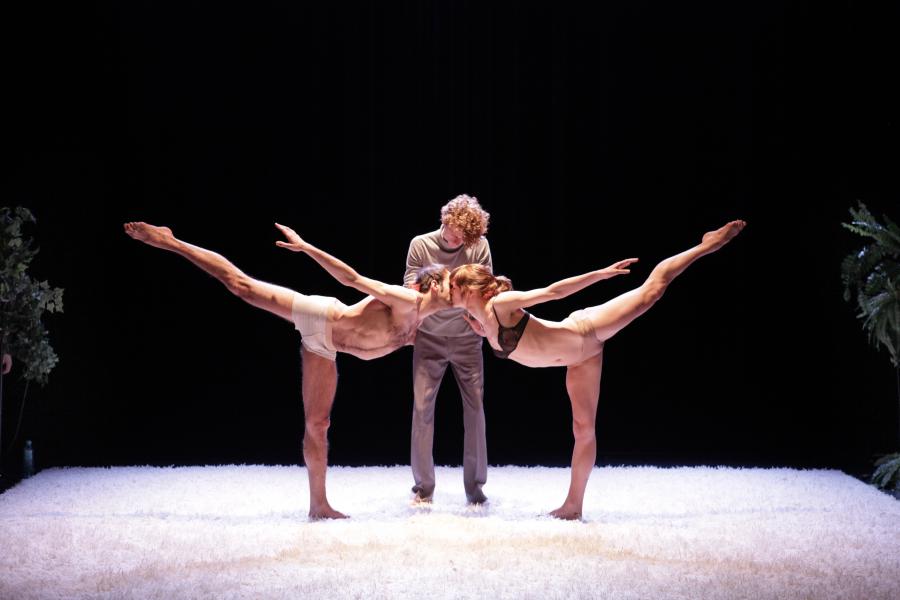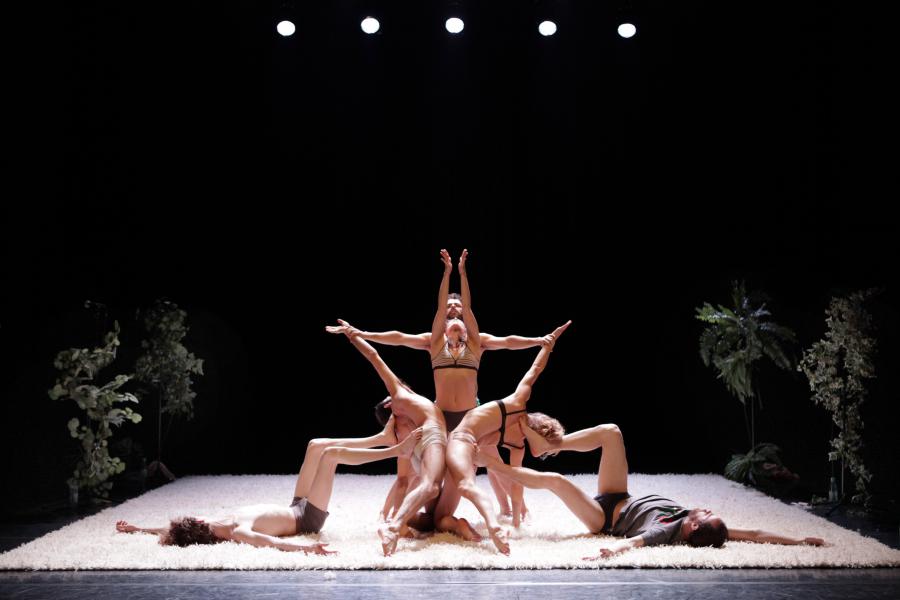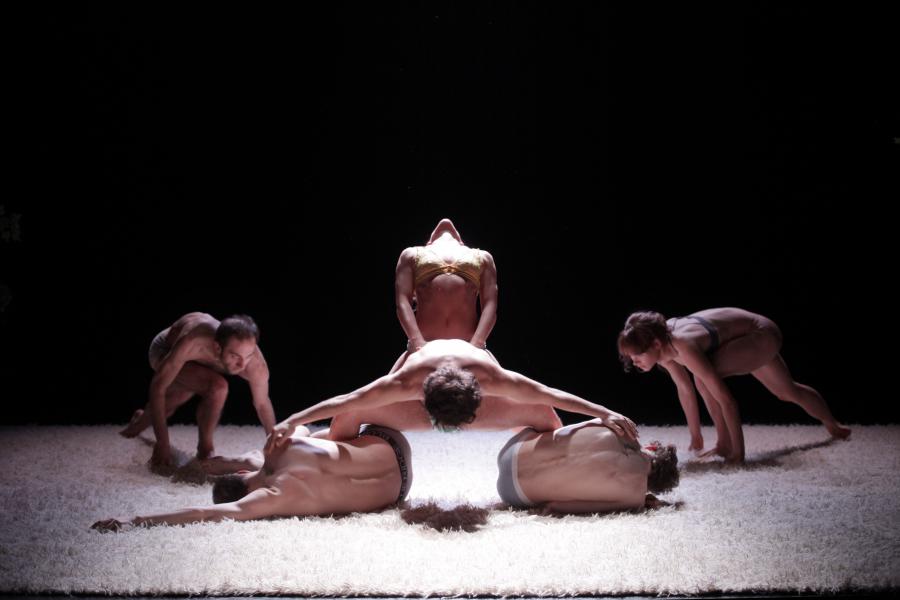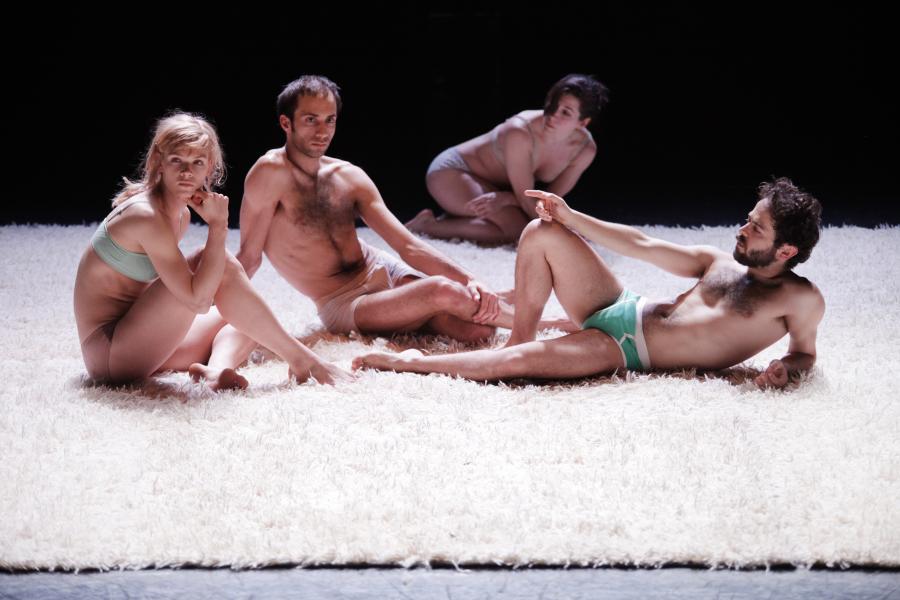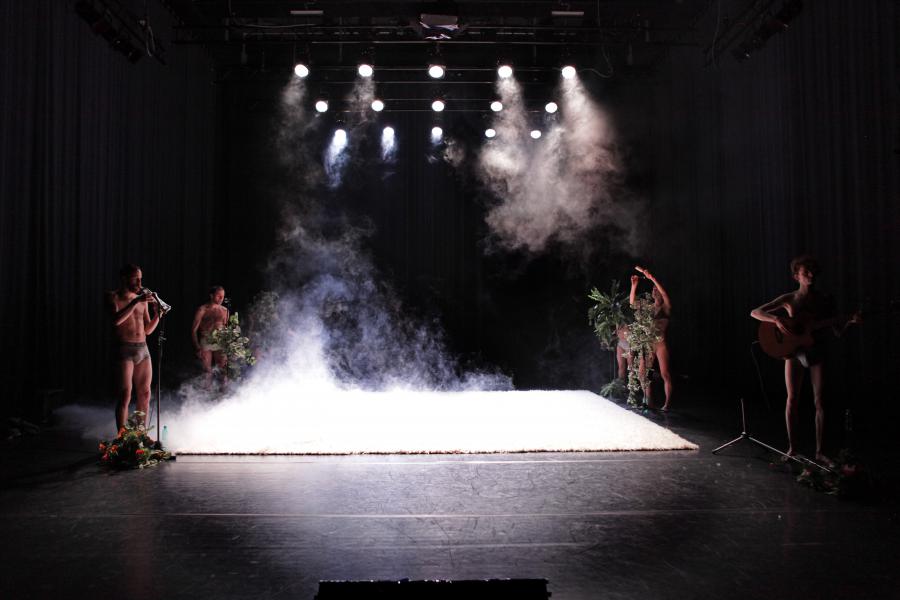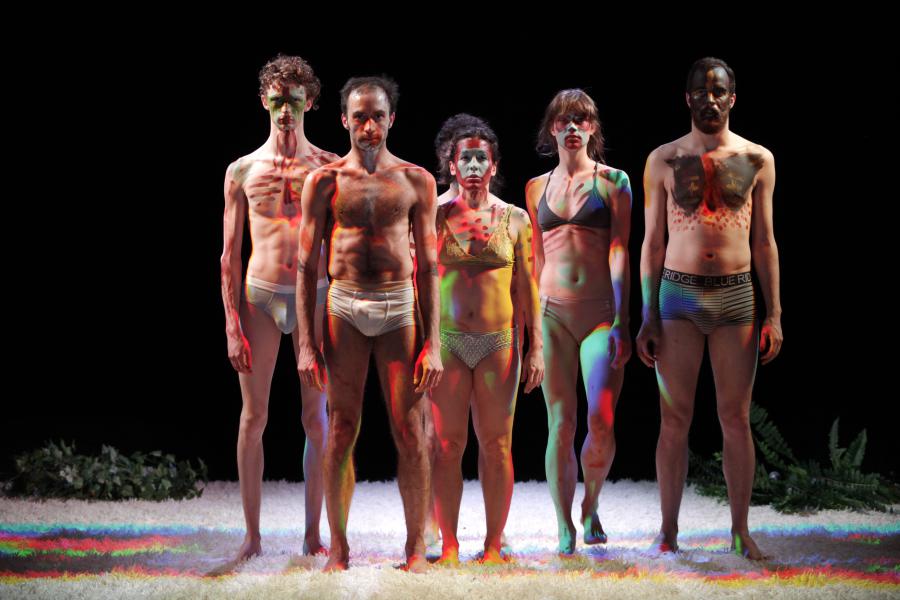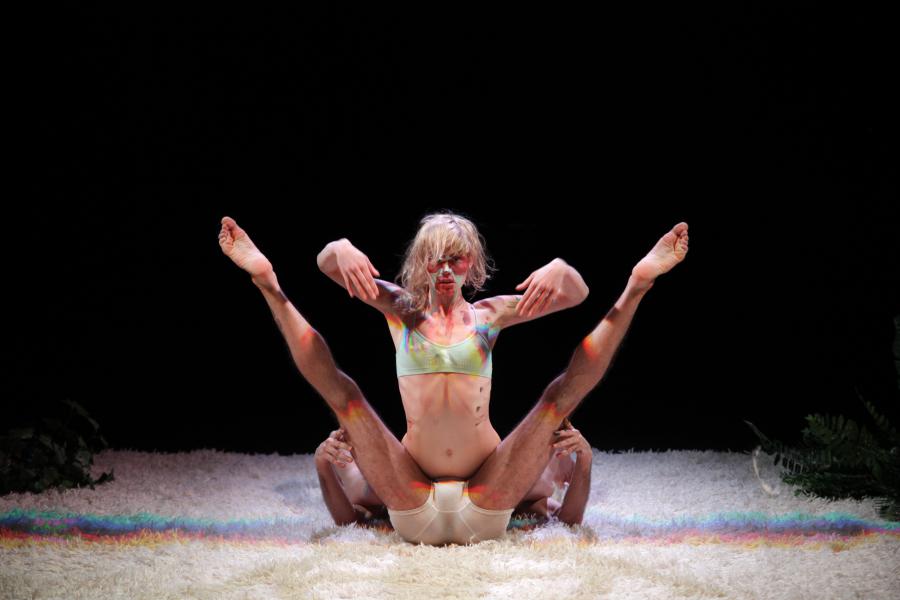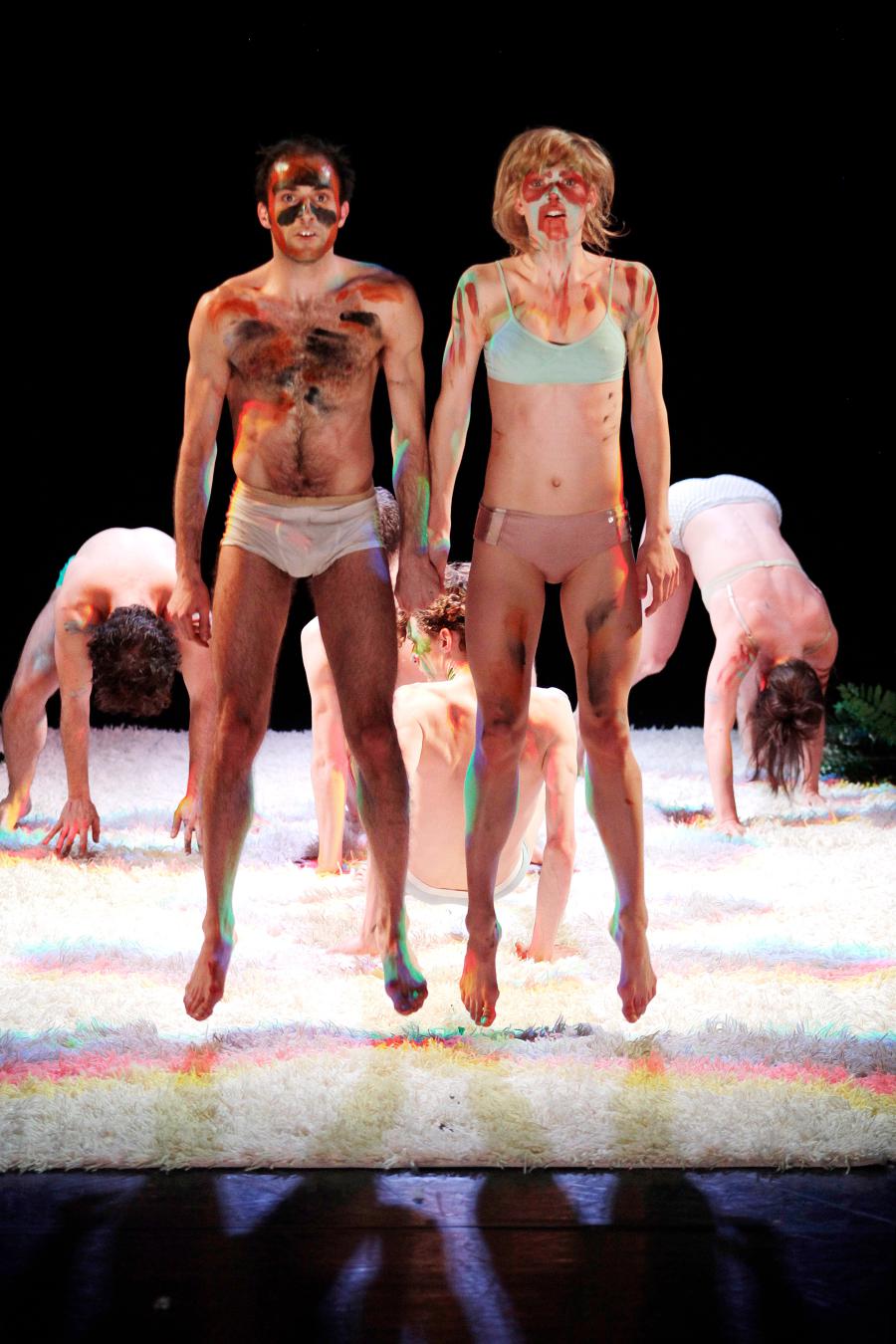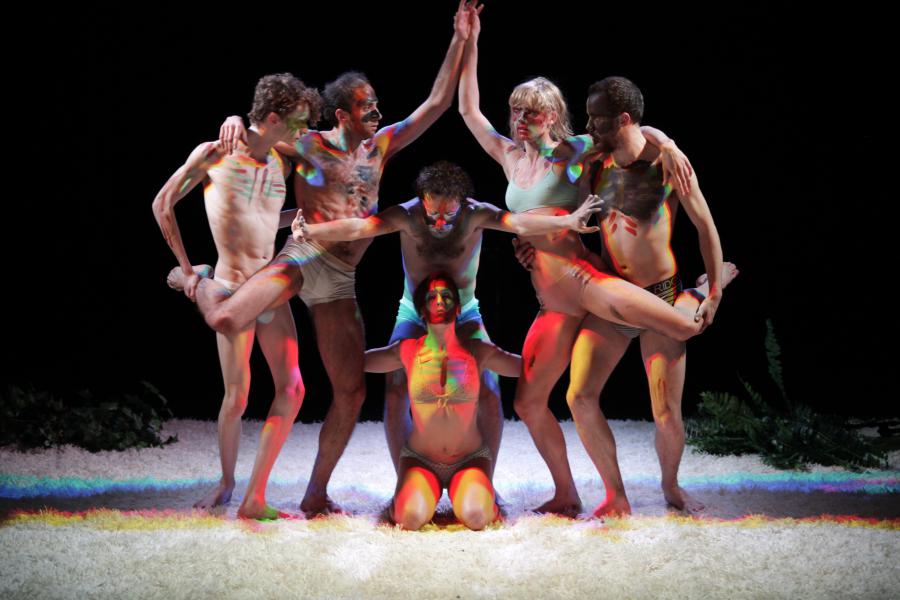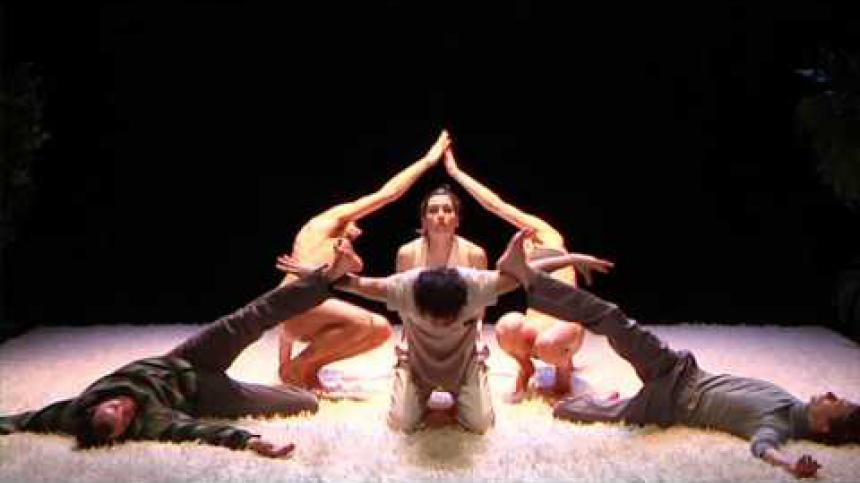Symmetry is one of the most fundamental concepts in geometry... It is so prevalent in nature, from the human body to crystals, atoms, particle physics, or cosmology, that it is difficult to imagine it not being central to our understanding of the world. (Jean-Pierre Luminet: Science, Art and Geometrical Imagination)
The dream of getting back to nature is an ageless one. Nature represents all that is pure, real and unbridled, in contrast to everything that has been touched by humankind – culture – which is civilized, orderly and contrived. Choreographer Nicole Beutler’s takes these platitudes to task in 3: The Garden. Because although nature is indeed wild and unspoiled, symmetry is fundamental to it; not a single atom or crytal escapes it. The acrobatic dancers in Beutler’s Garden of Eden create perfectly reflected symmetrical forms, like the beads in some hallucinogenic kaleidoscope. But, very gradually, driven on by music from DJ/composer Gary Shepherd and the anti-pop band Einstürzende Neubauten this restrained aesthetic goes off the rails and humans themselves become the instigators of a raging chaos.
Beutler drew inspiration from both the contemporary zeitgeist and far older sources for whom nature had a special status: the pre-socratic natural philosophers, the Romantics and Monte Verità, the early twentieth century artistic community in Switzerland. She also gives the theory of evolution the chance to play around with the biblical creation story and lets the influence of Jeroen Bosch’s exuberant painting The Garden of Earthly Delights shine through.
With her strongly composed images, Beutler creates theatre in which dance, text, music and visual arts melt together as one.
REVIEWS
-
A strong performance with hypnotic moments, lots of variety and humor
Due to its success, the performance 3: The Garden by NBprojects from 2011 can be seen again in theaters in the Netherlands. Nicole Beutler and her team have adapted the performance so that it now fits in the main hall, instead of the small hall. On the floor of the stage we see a square grass mat with three short fake trees on both sides. A normally dressed young man tells us animatedly about the moment when there was nothing and the big bang and lists things, places and people who are or have been on earth. Meanwhile, five others appear. The group dance that follows consists of a constant change from one symmetrical shape to another, much like a human kaleidoscope. The flowing movements prove that the dancers, now stripped down to their underwear, are well attuned to each other. Although they continue with these movements for quite a long time at the beginning, the music, which becomes softer and then stronger again, and the light, which goes from the entire room to a single bright spotlight on the stage, ensure that it does not become boring, but rather has a hypnotic effect.
Strong tension The symmetrical group dance is the guiding principle in the performance, but is interrupted several times. For example, when the performers make a rhythm with instruments hidden in the fake trees and pronounce the text “You will find me, if you want me, in the garden, unless it’s pouring down with rain”, or when they draw patterns on top of each other with different colors of paint. Each interruption seems to have the effect of a change in the symmetrical group dance, from flowing to thrusting movements and from linear forward to circular facing each other. By combining the subtle light and music changes with the major interruptions, the performers hold the attention in an inventive and humorous way. Futuristic ideas Towards the end of the performance, one of the performers talks about futuristic things, people and places in an animated way, such as that we humans will be naked and will no longer need food. The circle is complete: from the beginning of the earth, through all the adjustments we humans have made to nature, to an image of the future. The performance ends very satisfactorily with the performers who assume an asymmetrical, harmonious group pose naked. Strengthening effect of the large hall It is striking that this performance also works very well in a large hall. The greater distance between performers and audience actually contributes to the hypnotic effect, because it is easier to look at the whole. 3: The Garden is, even more so in the main hall, a strong performance that has hypnotic moments, but also a lot of variety and humour.
-
Sin and innocence merge in Beutler's garden
In The Garden, Nicole Beutler returns to Monte Verità, the Swiss artists' colony where residents at the beginning of the last century walked around naked and made music, danced and gardened to the delight.
Rudolf von Laban (1879-1958) was there, he researched the basic principles of human movement. Gravity, balance and continuous energy characterized his dance - qualities that we see in Beutler's choreography. It starts with a man and a woman on snow-white artificial grass. They are the Adam and Eve of the left panel of Hieronymus Bosch's Garden of Earthly Delights, the other source of inspiration for The Garden.
This is followed by a stream of symmetrical sculptures and patterns executed with precision by six performers. When carnal lusts dominate, we have arrived at the central panel of Bosch's triptych. When we hear Einstürzende Neubauten, we reach hell - the last panel - where Bosch painted a score on a pair of bare buttocks. "You'll find me in the garden if you need me," the six sing together.
The beauty is that in Beutler's garden innocence and sin, flowers formed with bodies and fake grass and plants, through-composed dance formations and passionate animal sequences flow smoothly into one another. Gary Shepherd's contemporary beats make us realize there's no turning back. We ate the apple and we will never find a paradise forest again.
-
The stylization in this garden of Eden is perfect
"In the beginning there was nothing". The man in a checkered lumberjack shirt and with a soft Flemish accent speaks his semi-philosophical words about the origin of the world in a continuous line. It is a quality that will color the dynamics of the entire performance. A beautiful undercurrent that propels everything forward and links it organically. Even when the big bang sounds. Even when the timidly started song The Garden by Einsturzende Neubauten goes off the rails. Even when the dancers become increasingly entangled.
After productions inspired by heroines from stage literature (1: SONGS) and the grand dame of early minimalist dance (2: Dialogue with Lucinda), the German-Dutch choreographer Nicole Beutler has focused on another great theme with 3: The Garden: the relationship between nature and culture. They are understandings to which all kinds of opposing notions are connected. Nature is chaos, culture is order. Culture is literally and figuratively a step further than nature, a source to which (romantic) people now and then want to return. Beutler takes a closer look at this separate thinking with an original and bizarre image and movement language that are elaborated down to the millimeter and very musically.
On a rug between two rows of trees, four men and two women in underwear move like the stones in a magic lantern. In a mixture of dance, yoga and, in the distance, kamasutra, they form symmetrical patterns and figures. The stylization in this Garden of Eden is perfect. She is about form and energy, things that you can connect to how galaxies and oceans came into existence. And yet she is not correct. You do not associate this order with primal soup and the primal power of nature. Very gradually, Beutler reverses the alleged logic. Microphones emerge from under the leaves. Behold the human being, who cries out his desire, paints himself as a warrior and changes with others into a pumping mating organism of free love. Only now is the chaos there. Is this the back-to-nature effect or what civilization brings about? "Nature" and "culture" have been mixed up quite a bit. Just like in Japan tsunami and Fukushima have become confusingly similar.
Cast & Credits
Idea, Choreography, Directon: Nicole Beutler
Music: Gary Shepherd
Lighting design: Minna Tiikkainen
Created and performed by: Hillary Blake Firestone, Marjolein Vogels, Giulio d’Anna, Niels Kuiters, Hendrik Willekens, Javier Vaquero Ollero
Cast since 2015: Hillary Blake Firestone, Marjolein Vogels, Giulio d’Anna, Niels Kuiters, Christian Guerematchi(sinds 2015), Felix Schellekens
Dramaturgy: Felix Ritter
Repetitor: Keren Levi
Costume, Stage design Suze May Sho: Jessica Helbach, Rosell Heijmen, Connie Nijman
Light technique: Martin Kaffarnik
Sound technique: Valentijn Berkhout
A coproduction:Nicole Beutler Projects, Beursschouwburg Brussels, Grand Theatre Groningen
With support of: Fonds Podiumkunsten, Gemeente Amsterdam, Amsterdams Fonds voor de Kunst
Graphic design: Connie Nijman
Many thanks to: Paul Schimmel, Hester van Hasselt (Coördinatie Context Programma), Anouke de Groot (assistentie), Signe Tollefsen (voice-training), Robert Steijn (power animals), Bojana Mladenovic, Hester van Hasselt, Michael Jahoda

